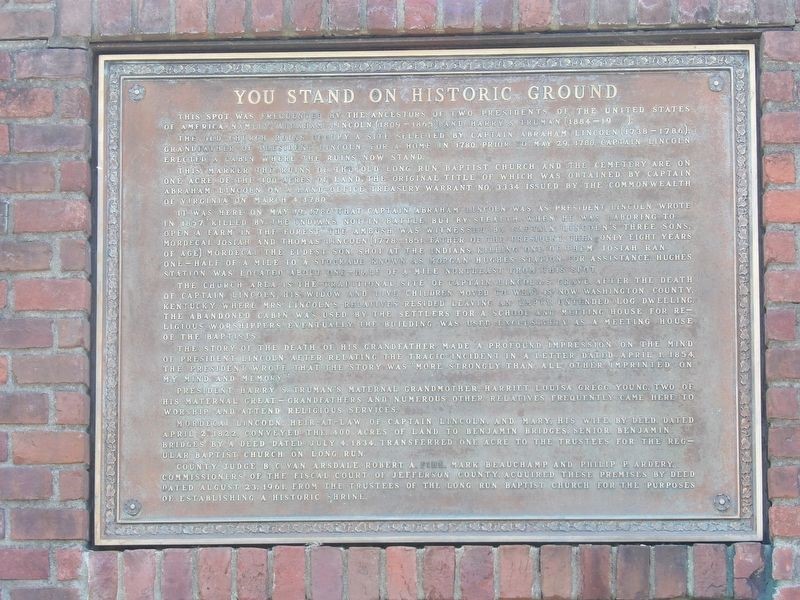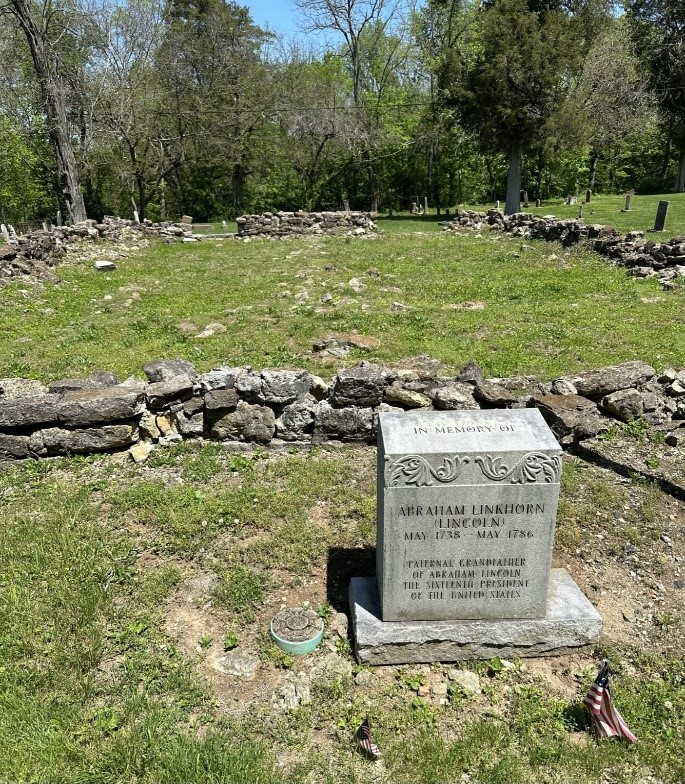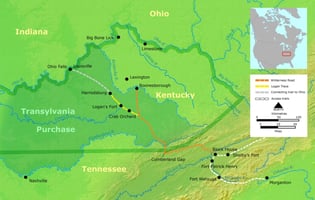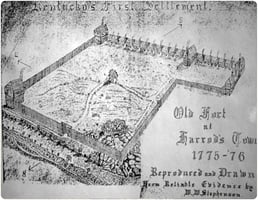Please check open hours before you go! Some sites have odd schedules, or only have buildings open...
Introducing the Lincoln Family
One of the early settlers who traversed the Wilderness Road was Revolutionary War Captain Abraham Lincoln (sometimes spelled “Linkhorn”), who was related to the Boone family by marriage, likely spurring this migration. https://www.friendsofthelincolncollection.org/lincoln-lore/an-assessment-of-thomas-lincoln/
On May 29, 1780, Captain Abraham registered the purchase of 400 acres of land in eastern Jefferson County, near Floyd’s Fork. Morgan Hughes (or Hues) registered 500 acres adjoining Lincoln’s land on the same day. Although defenses had been established to prevent Native Americans from crossing the Ohio River to bother settlers, there was more risk of trouble in this area than further south. Undoubtedly they worked together to build what would soon be known as Hughes’ Station near the border between the properties, which "consisted of eight cabins and four block houses at the corners and . . . was a weak fort poorly built.” https://www.friendsofthelincolncollection.org/wp-content/uploads/2018/08/LL_1936-08-24_01.pdf Stations of this sort were plentiful, over 200 were documented in early Kentucky: they were generally effective in providing protection for the inhabitants, while still allowing settlers to access and improve their land in anticipation of the time when they no longer feared attacks from Native Americans.

In May, 1786, Captain Abraham Lincoln was working in his corn field with sons Mordecai (age 15), Josiah (age 12) and Thomas (age 9) when they were surprised by a Native American strike. The father of the family was killed, Mordecai ran to their cabin to get the gun, and Josiah ran for Hughes’ Station about a half a mile away to get help. Luckily for young Tom, Mordecai was a good shot and killed the Native American running towards him. Only thanks to the quick action of his oldest brother Mordecai did Tom, beside his father, survive. Captain Abraham was buried very near to the cabin he had built for his family, but never had the chance to inhabit.

“The old church ruins occupy a site selected by Captain Abraham Lincoln (1738-1786), grandfather of President Lincoln, for a home in 1780. Prior to May 29, 1780, Captain Lincoln erected a cabin where the ruins now stand.
This marker, the ruins of the old Long Run Baptist Church and the cemetery are on one acre of the 400 acres of land, the original title of which was obtained by Captain Abraham Lincoln on a land-office treasury warrant No. 3334 issued by the Commonwealth of Virginia on March 4, 1780.
It was here on May 19, 1786 that Captain Abraham Lincoln was, as President Lincoln wrote in 1857, “killed by the Indians, not in battle but by stealth when he was laboring to open a farm in the forest.” The ambush was witnessed by Captain Lincoln's three sons, Mordecai, Josiah and Thomas Lincoln (1778- 1851, father of the president, then only eight years of age). Mordecai, the eldest son, shot at the Indians, killing one of them. Josiah ran one-half of a mile to a stockade known as Morgan Hughes Station for assistance. Hughes Station was located about one-half of a mile northeast from this spot.
The church area is the traditional site of Captain Lincoln's grave. After the death of Captain Lincoln, his widow and five children moved to what is now Washington County, Kentucky, where Mrs. Lincoln's relatives resided leaving an empty, untended log dwelling. The abandoned cabin was used by the settlers for a school and meeting house for religious worshippers. Eventually the building was used exclusively as a meeting house of the Baptists.
The story of the death of his grandfather made a profound impression on the mind of President Lincoln. After relating the tragic incident in a letter dated April 1, 1854, the president wrote that the story was “more strongly than all other imprinted on my mind and memory.””
According to the laws of that time the eldest son, Mordecai, inherited most of his father’s estate at age 21, while the other children inherited nothing and had no practical opportunity for schooling. In that environment teachers were few and far between, as formal education was of little benefit: almost everyone’s livelihood depended on hunting and farming, possibly augmented by a more specialized trade like blacksmithing or shoemaking.
The uninhabited cabin at Long Run was used for a school and a church which was later expanded over the place of his grave and those of four other people. Long Run Church and Cemetery (on Old Coach Rd.), clearly showing the foundation of the church which was built partly on the foundation of Captain Abraham’s log cabin (back right in the photo below), is accessible today.

Widowed at age 44, Bathsheba moved her five children who ranged in age from roughly 6 to 15 to an area now included in Lincoln Homestead State Park near Springfield, Kentucky.

This area was more thickly settled, with less risk of Native American attacks. She most likely had other family there: some surviving legal documents were witnessed by Hananiah Lincoln, who reportedly borrowed money from his cousin Captain Abraham to purchase his own land.


